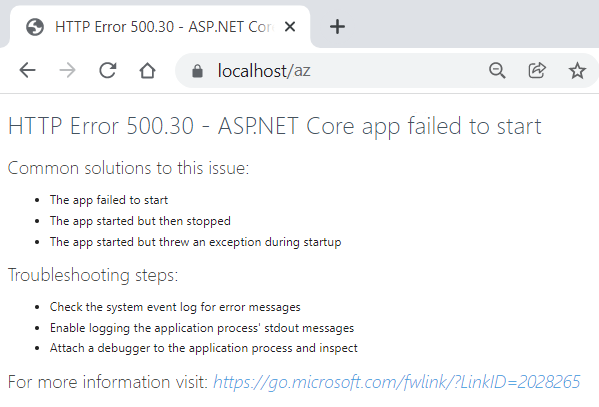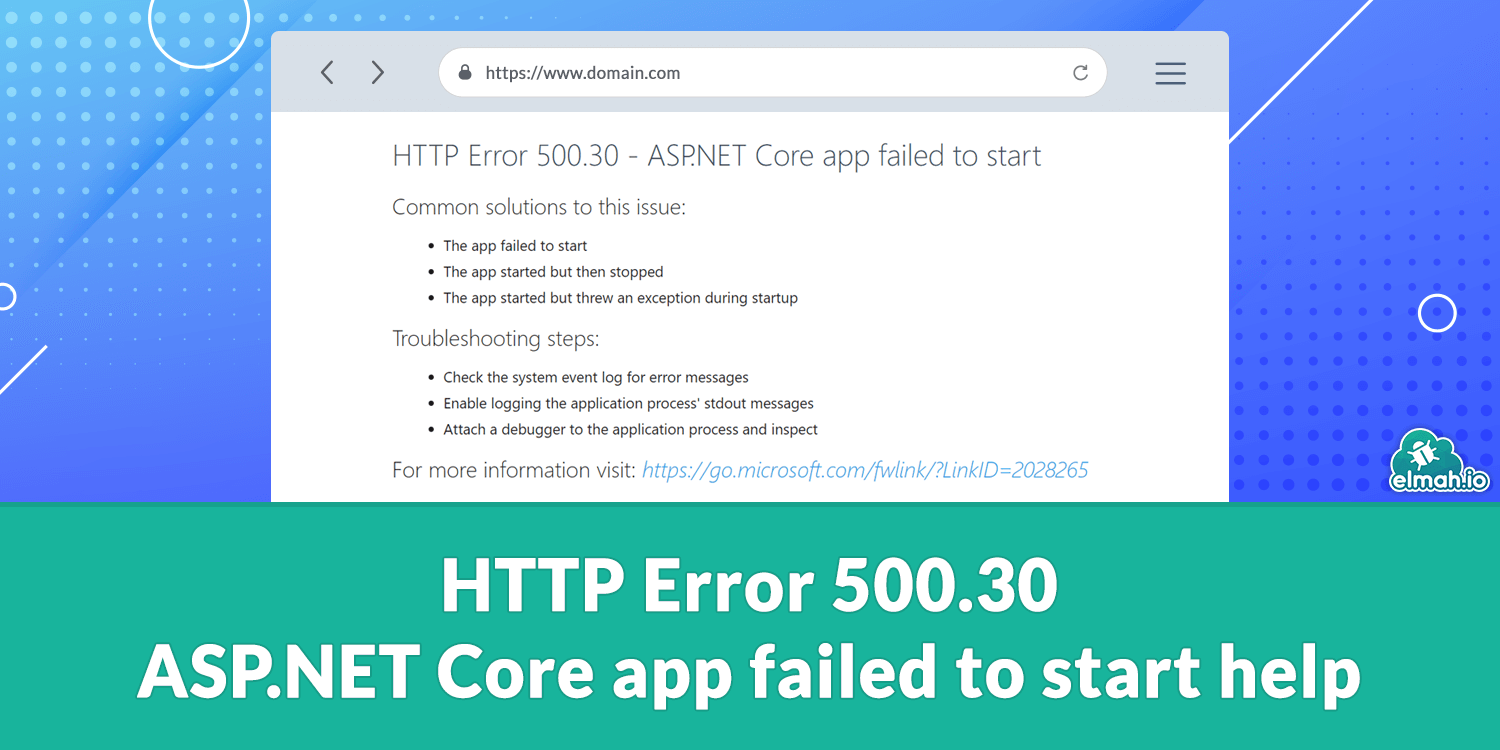Http Error 500.30 indicates that the Asp.Net Core app failed to start. This error often occurs due to configuration issues or missing dependencies.
Understanding and resolving Http Error 500. 30 is crucial for maintaining the smooth operation of your Asp. Net Core applications. This error signifies a failure during the startup process, which can be caused by various factors such as incorrect configurations, missing dependencies, or permission issues.
Identifying the root cause quickly helps in minimizing downtime and ensuring a seamless user experience. Common troubleshooting steps include checking the application’s event logs, verifying configuration files, and ensuring that all necessary dependencies are correctly installed. By addressing these issues promptly, you can restore your application’s functionality and improve overall performance.
Common Causes
Http Error 500.30 indicates a failure in starting an Asp.Net Core application. Understanding the common causes can help resolve this error quickly. Below, we explore some typical issues.
Configuration Issues
Configuration problems often lead to the 500.30 error. Incorrect settings in the appsettings.json file can cause the application to fail.
- Missing or incorrect database connection strings.
- Incorrect environment settings.
- Improper logging configurations.
Ensure that your configuration files are correct. Validate all settings and paths used in these files.
Dependency Failures
Dependencies play a crucial role in the startup of an Asp.Net Core application. Missing or incompatible dependencies can halt the startup process.
| Common Dependencies | Potential Issues |
|---|---|
| Database | Unavailable or inaccessible database server. |
| Third-party Services | API keys or endpoints misconfigured. |
| Packages | Missing NuGet packages or version conflicts. |
Make sure all dependencies are correctly installed and configured. Check for any version conflicts and resolve them accordingly.

Credit: freeasphosting.net
Diagnosing The Problem
Encountering the HTTP Error 500.30 in your ASP.NET Core app can be frustrating. The app fails to start, leaving you puzzled. Diagnosing this issue is crucial for a quick resolution. Let’s explore effective methods to pinpoint the problem.
Checking Logs
Start by checking the logs. Logs provide clues about what went wrong. Look for any error messages or warnings.
- Open the
Event Vieweron your server. - Navigate to
Windows Logsand thenApplication. - Look for errors related to your ASP.NET Core app.
- Also, check the
stdoutlogs in the app’s directory.
Logs can help identify missing dependencies or configuration issues.
Using Diagnostic Tools
Utilize diagnostic tools to investigate further. These tools provide deeper insights.
- Use dotnet-trace to capture traces of your application.
- Run dotnet-counters for real-time performance metrics.
- Use dotnet-dump to capture memory dumps for analysis.
These tools help you understand what’s happening under the hood.
| Tool | Purpose |
|---|---|
| dotnet-trace | Captures detailed traces. |
| dotnet-counters | Monitors performance metrics. |
| dotnet-dump | Captures memory dumps. |
Using these tools can help you diagnose the root cause quickly.
Configuration Fixes
The HTTP Error 500.30 – Asp.Net Core App Failed to Start is a common issue. It usually signals a configuration problem. Fixing configurations can resolve this error. Let’s explore some effective configuration fixes.
Correcting Web.config
The Web.Config file is crucial. It controls many application settings. Errors in this file can cause the app to fail.
Follow these steps to correct Web.Config:
- Open the
Web.Configfile in a text editor. - Check for any syntax errors.
- Ensure the
section is configured properly.
Here is a sample Web.Config setup:

Make sure to:
- Replace
"SettingName"and"SettingValue"with your actual settings. - Update the
connectionStringandproviderNamewith your database details. - Adjust the
targetFrameworkto match your application’s framework version. - Configure
authenticationandauthorizationsettings as needed for your application.
By carefully reviewing and updating the Web.config file, you can ensure your application runs smoothly and efficiently.
Updating Appsettings
The AppSettings file contains key settings. Incorrect values here can prevent the app from starting.
To update AppSettings:
- Open
appsettings.jsonin a text editor. - Look for any incorrect values or typos.
- Ensure all required settings are present and accurate.
Here’s an example of a typical appsettings.json file:
{
"Logging": {
"LogLevel": {
"Default": "Information",
"Microsoft": "Warning",
"Microsoft.Hosting.Lifetime": "Information"
}
},
"AllowedHosts": ""
}
Ensure the Logging and AllowedHosts sections are correctly set up. Improper settings can lead to startup failures.
By carefully reviewing and updating these configurations, you can often resolve the HTTP Error 500.30.
Dependency Resolutions
Experiencing an HTTP Error 500.30 with your ASP.NET Core app can be frustrating. This error often relates to issues with dependency resolutions. Ensuring your libraries and frameworks are compatible is crucial for smooth app operations.
Ensuring Library Compatibility
One common cause of HTTP Error 500.30 is incompatible libraries. Libraries must work well together. If one library is outdated, it can break the app.
Check the version numbers of all your libraries. Ensure they match the required versions. Use a dependency manager to keep track of your libraries.
- Verify library versions
- Check compatibility
- Update outdated libraries
Use tools like NuGet to manage library versions. This tool helps maintain compatibility.
Updating .net Core
Another key step is updating your .NET Core runtime. An outdated runtime can cause errors.
First, check your current .NET Core version. Compare it with the latest version on the official website.
| Current Version | Latest Version |
|---|---|
| 3.1 | 5.0 |
| 2.1 | 5.0 |
If your version is outdated, update it. Follow the official installation guide for the latest .NET Core.
After updating, rebuild your application. This ensures all dependencies align with the new runtime.
Preventative Measures
Facing the Http Error 500.30 – Asp.Net Core App Failed to Start can be daunting. Preventing this issue involves several key steps. Implementing these measures can save time and headaches.
Regular Updates
Keep your software up to date. Regular updates are crucial. Use the latest versions of ASP.NET Core and related dependencies. This ensures compatibility and security.
- Update your NuGet packages frequently.
- Check for new SDK releases and install them.
- Review the Microsoft documentation for changes.
Monitoring And Alerts
Set up monitoring for your application. Alerts help detect problems early. This can prevent downtime and improve reliability.
- Use Application Insights for detailed monitoring.
- Configure email or SMS alerts for critical issues.
- Review logs regularly to spot trends.
A well-monitored application is less likely to fail. Take these steps to ensure your ASP.NET Core app runs smoothly.

Credit: blog.elmah.io

Credit: stackoverflow.com
Frequently Asked Questions
How To Fix Http Error 500.30 Asp.net Core App Failed To Start?
Check the app’s logs for detailed errors. Ensure all dependencies are installed. Verify correct configuration settings. Update. NET Core runtime. Restart the application.
What Is 500.30 In Process Startup Failure Azure?
A 500. 30 in-process startup failure in Azure indicates that the application failed to start. This error often occurs due to misconfigurations or missing dependencies. Ensure all required files and settings are correctly configured to resolve it.
What Is 500 Internal Server Error .net Core Web Api?
A 500 Internal Server Error in a. NET Core Web API indicates a server malfunction. It often results from unhandled exceptions.
How To Enable Logging The Application Process Stdout Messages?
Enable logging by redirecting stdout to a file. Use `application > logfile. txt` in command line. This captures all stdout messages.
What Causes Http Error 500.30 In Asp.net Core?
Http Error 500. 30 is caused by application startup failures.
How Can I Fix Http Error 500.30?
Check the application logs for specific errors and resolve them.
Conclusion
Resolving the HTTP Error 500. 30 in your ASP. NET Core app is crucial for smooth functionality. Follow the steps outlined to troubleshoot effectively. Regular maintenance and updates can prevent future issues. A well-functioning app ensures a better user experience and improved performance.
Stay proactive to keep your application running seamlessly.

Joseph Davis a researcher and content strategist with over 16 years of experience in development and web technologies. Backed by a master’s degree in computer science, he leverages his expertise to review software and digital assets through thorough research.
